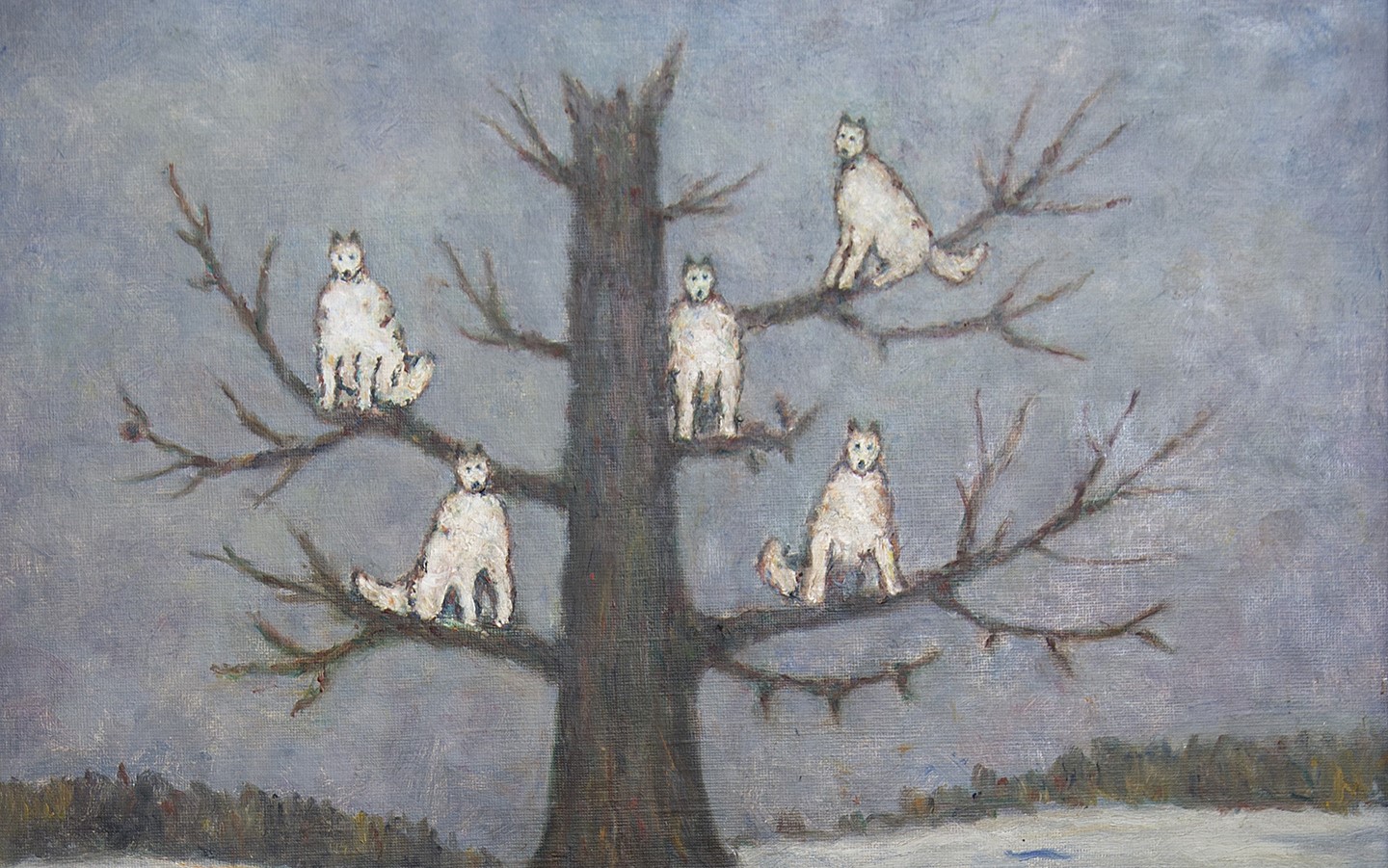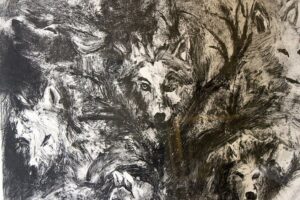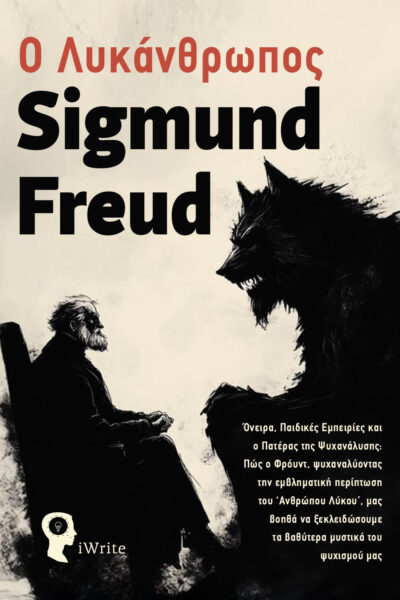Ψυχανάλυση, τα όνειρα, το ασυνείδητο και ο λυκάνθρωπος του Φρόιντ: Τι μας λένε οι εφιάλτες μας;
Έχετε ξυπνήσει ποτέ νιώθοντας ότι ένα όνειρο σας άφησε κάτι παραπάνω από μια απλή ανάμνηση; Ένας ανεξήγητος φόβος, ένα παράξενο συναίσθημα ή ακόμα και η αίσθηση ότι κάτι πολύ βαθύτερο συμβαίνει στο μυαλό σας;
Οι εφιάλτες, ειδικά αυτοί που επαναλαμβάνονται, μας στοιχειώνουν χωρίς προφανή λόγο. Όμως, αν τους προσέξετε καλύτερα, ίσως συνειδητοποιήσετε ότι το μυαλό σας προσπαθεί να σας πει κάτι.
Φανταστείτε κάποιον που, κάθε φορά που κοιμάται, βλέπει το ίδιο τρομακτικό όνειρο: ένα παράθυρο που ανοίγει, ένα δέντρο γεμάτο λευκούς λύκους, μάτια που τον κοιτάζουν ασταμάτητα. Η εικόνα είναι ακίνητη, παγωμένη, σαν να έχει σταματήσει ο χρόνος. Δεν υπάρχει βία, δεν υπάρχει απειλή, όμως ο φόβος είναι ασφυκτικός. Τι σημαίνει κάτι τέτοιο; Είναι απλώς μια σύμπτωση ή κρύβει μια βαθύτερη αλήθεια;
Η ψυχανάλυση, όπως την ανέπτυξε ο Σίγκμουντ Φρόιντ, θεωρεί ότι τέτοια όνειρα δεν είναι ποτέ τυχαία. Δεν είναι απλώς φανταστικά σενάρια που δημιουργεί ο εγκέφαλός μας, αλλά συμβολικές εικόνες που κρύβουν τραύματα, φόβους και απωθημένες αναμνήσεις. Πίσω από κάθε όνειρο, υπάρχει ένα μήνυμα—κάτι που το ασυνείδητό μας θέλει να αποκαλύψει, αλλά εμείς δεν είμαστε έτοιμοι να ακούσουμε.
Όμως, τι θα γινόταν αν ένα όνειρο δεν ήταν απλώς ένα ψυχικό φαινόμενο, αλλά το κομμάτι ενός παζλ που εξηγεί μια ολόκληρη ζωή; Αν μια επαναλαμβανόμενη εικόνα έκρυβε το μυστικό ενός τραύματος που ποτέ δεν αναγνωρίσαμε συνειδητά; Υπάρχει μια υπόθεση που αποδεικνύει ότι αυτό δεν είναι απλώς θεωρία.
Η ψυχανάλυση του Φρόιντ και η ερμηνεία των ονείρων
Στις αρχές του 20ού αιώνα, η ψυχανάλυση έφερε μια ριζοσπαστική αλλαγή στον τρόπο που οι άνθρωποι αντιλαμβάνονταν τα όνειρα. Μέχρι τότε, η ερμηνεία των ονείρων βασιζόταν σε μυστικιστικές και προφητικές αντιλήψεις, ενώ η επιστήμη τα θεωρούσε απλές νευρολογικές διεργασίες χωρίς ιδιαίτερη σημασία.
Το 1900, ο Σίγκμουντ Φρόιντ δημοσίευσε το έργο του “Η Ερμηνεία των Ονείρων”, το οποίο όχι μόνο θεμελίωσε την ψυχανάλυση ως επιστημονικό κλάδο, αλλά και καθόρισε μια εντελώς νέα προσέγγιση στη μελέτη του ασυνείδητου.
Ο Φρόιντ υποστήριξε ότι τα όνειρα δεν είναι τυχαία ή ασήμαντα, αλλά αντιθέτως, αποτελούν συμβολικές αναπαραστάσεις επιθυμιών, συγκρούσεων και καταπιεσμένων αναμνήσεων. Σύμφωνα με την ψυχανάλυση, κάθε όνειρο έχει δύο επίπεδα:
1. Το έκδηλο περιεχόμενο: η επιφανειακή εικόνα του ονείρου, δηλαδή ό,τι βλέπει κάποιος όταν ονειρεύεται.
2. Το λανθάνον περιεχόμενο: το βαθύτερο νόημα που κρύβεται πίσω από το όνειρο, το οποίο περιέχει απωθημένες επιθυμίες, φόβους και τραύματα.
Η ψυχανάλυση θεωρεί ότι το μυαλό χρησιμοποιεί μηχανισμούς λογοκρισίας, ώστε να αποκρύψει το αληθινό νόημα του ονείρου. Για παράδειγμα, μια φοβία μπορεί να εμφανιστεί σε ένα όνειρο μέσα από έναν συμβολισμό, αντί για την πραγματική της μορφή. Αυτός ο μηχανισμός επιτρέπει στο ασυνείδητο να εκφράζεται έμμεσα, χωρίς να προκαλεί άμεση ψυχική σύγκρουση.
Ο μηχανισμός της εργασίας του ονείρου (dream-work), όπως τον διατύπωσε ο Φρόιντ, περιλαμβάνει τέσσερις ψυχικές διεργασίες που παραμορφώνουν το αληθινό μήνυμα του ασυνείδητου ώστε να γίνει πιο αποδεκτό από το συνειδητό νου:
Συμπύκνωση: Πολλαπλές έννοιες συμπυκνώνονται σε μία εικόνα.
Μετατόπιση: Ένα συναίσθημα αποδίδεται σε κάτι διαφορετικό από την αρχική του πηγή.
Συμβολοποίηση: Οι έννοιες του ασυνείδητου εκφράζονται μέσω συμβόλων.
Δευτερογενής επεξεργασία: Το όνειρο αναδιοργανώνεται ώστε να αποκτήσει λογική δομή.
Ο Λυκάνθρωπος και η ψυχανάλυση: Η πιο διάσημη μελέτη του Φρόιντ
Σύμφωνα με τον Φρόιντ, οι περισσότεροι εφιάλτες είναι ενδείξεις εσωτερικών συγκρούσεων που αναζητούν επίλυση. Τα όνειρα, επομένως, λειτουργούν ως ένα είδος ψυχικής διεργασίας που προσπαθεί να λύσει προβλήματα του παρελθόντος. Αυτός ο μηχανισμός ερμηνείας των ονείρων απέκτησε ιδιαίτερη σημασία στην ψυχανάλυση και εφαρμόστηκε σε πολλές διάσημες περιπτώσεις, με πιο χαρακτηριστική την υπόθεση του «Λυκάνθρωπου».
Η υπόθεση αυτή έδειξε ξεκάθαρα πώς ένα όνειρο μπορεί να αποτελέσει το κλειδί για την αποκάλυψη ενός βαθιά κρυμμένου τραύματος. Το όνειρο ενός ανθρώπου που βλέπει σταθερά λύκους να τον κοιτάζουν μπορεί να μοιάζει αρχικά με έναν τυχαίο εφιάλτη. Ωστόσο, η ψυχανάλυση του Φρόιντ απέδειξε ότι τίποτα δεν είναι τυχαίο όταν πρόκειται για το ασυνείδητο.
Το όνειρο του Λυκάνθρωπου: Μια ψυχαναλυτική αποκάλυψη
Το 1918, ο Σίγκμουντ Φρόιντ δημοσίευσε την πιο διάσημη και λεπτομερή μελέτη περίπτωσης της καριέρας του: την ανάλυση ενός Ρώσου αριστοκράτη που έμεινε γνωστός ως «Ο Λυκάνθρωπος».
Το πραγματικό του όνομα ήταν Σεργκέι Πάνκετσεφ, ένας άνδρας που έπασχε από έντονες νευρωτικές διαταραχές, οι οποίες περιλάμβαναν καταθλιπτικά επεισόδια, φοβίες και έντονο ψυχικό πόνο.
Η ζωή του Πάνκετσεφ χαρακτηριζόταν από ψυχαναγκαστικές συμπεριφορές και αδυναμία λήψης αποφάσεων, σε σημείο που είχε φτάσει να εξαρτάται πλήρως από τους γύρω του. Ο Φρόιντ ανέλαβε να διερευνήσει τη ρίζα του προβλήματός του μέσω της ψυχανάλυσης, και γρήγορα συνειδητοποίησε ότι στο επίκεντρο της περίπτωσής του βρισκόταν ένα συγκεκριμένο όνειρο.
Ο ασθενής περιέγραφε έναν επαναλαμβανόμενο εφιάλτη, που τον κυνηγούσε από την παιδική του ηλικία και του προκαλούσε τρομερό φόβο. Το όνειρο είχε ως εξής:
“Ένα χειμωνιάτικο πρωινό, ξαπλωμένος στο κρεβάτι, βλέπω το παράθυρο να ανοίγει από μόνο του. Έξω, πάνω σε ένα μεγάλο καρύδι, υπάρχουν έξι ή επτά λευκοί λύκοι που κάθονται ακίνητοι στα κλαδιά και με κοιτούν επίμονα. Νιώθω τρόμο, είμαι βέβαιος ότι οι λύκοι θα με καταβροχθίσουν, ουρλιάζω και ξυπνάω.”
Ο ασθενής έβλεπε ξανά και ξανά το ίδιο όνειρο. Παρόλο που οι λύκοι δεν τον απειλούσαν άμεσα, η απλή παρουσία τους του προκαλούσε έντονο φόβο. Το πιο παράδοξο ήταν η ακινησία τους—δεν κινούνταν, δεν έδειχναν επιθετικότητα, αλλά η ύπαρξή τους και μόνο τον κατέκλυζε με πανικό.
Ο Φρόιντ άρχισε να ερευνά τι μπορούσε να σημαίνει αυτό το όνειρο και ανακάλυψε ότι δεν ήταν απλώς ένας εφιάλτης, αλλά μια βαθιά ψυχική καταγραφή ενός καταπιεσμένου τραύματος.
Η περίπτωση του Λυκάνθρωπου δεν είναι απλώς ένα ιστορικό ψυχαναλυτικό ντοκουμέντο. Είναι μια από τις πιο σημαντικές αποδείξεις της θεωρίας του Φρόιντ, που δείχνει πώς ένα όνειρο μπορεί να κρύβει ένα ολόκληρο παρελθόν που το άτομο έχει θάψει στο ασυνείδητό του. Αυτό ακριβώς εξηγεί με λεπτομέρεια και απόλυτη επιστημονική τεκμηρίωση το βιβλίο Ο Λυκάνθρωπος, το οποίο περιέχει την πλήρη ανάλυση του Φρόιντ πάνω σε αυτή την υπόθεση, συνοδευόμενη από τις προσωπικές σημειώσεις του ίδιου του ασθενούς, όπου αποτυπώνει τη δική του εκδοχή για τη θεραπεία, τις αναμνήσεις του και την επίδραση της ψυχανάλυσης στη ζωή του.
Η ερμηνεία του Φρόιντ: Όνειρα, ψυχανάλυση και καταπιεσμένες μνήμες
Ο Φρόιντ δεν άργησε να συνειδητοποιήσει ότι το όνειρο των λύκων δεν ήταν ένα τυχαίο προϊόν του υποσυνείδητου, αλλά ένα βαθιά ριζωμένο ψυχικό σύμπτωμα. Μέσα από τις συνεδρίες ψυχανάλυσης, οδηγήθηκε σε μια αποκάλυψη: το όνειρο του ασθενούς δεν αφορούσε τους λύκους αυτούς καθαυτούς, αλλά κάτι πολύ πιο βαθύ.
Οι λύκοι αντιπροσώπευαν ένα ισχυρό σύμβολο της πατρικής φιγούρας, και συγκεκριμένα του ίδιου του πατέρα του ασθενούς. Μέσα από την ανάλυση του ονείρου, ο Φρόιντ ανέπτυξε τη θεωρία της «πρωταρχικής σκηνής», η οποία υποστηρίζει ότι ένα παιδί μπορεί να γίνει μάρτυρας ενός τραυματικού γεγονότος χωρίς να έχει την ψυχολογική ικανότητα να το κατανοήσει εκείνη τη στιγμή.
“Το όνειρο των λύκων δεν ήταν απλώς ένας εφιάλτης. Ήταν η αναπαράσταση μιας μνήμης που δεν μπορούσε να εκφραστεί αλλιώς—μια ανάμνηση τόσο τραυματική, που είχε μετατραπεί σε σύμβολο.”
Ο Φρόιντ υποστήριξε ότι, όταν ο Πάνκετσεφ ήταν περίπου τριών ετών, βίωσε μια πολύ έντονη και συγκλονιστική εμπειρία, η οποία καταγράφηκε στο ασυνείδητό του χωρίς να μπορεί να την κατανοήσει. Αργότερα, το μυαλό του μετέτρεψε αυτή τη μνήμη σε όνειρο, με σκοπό να επανεπεξεργαστεί το τραύμα.
Η ερμηνεία του Φρόιντ στηρίχθηκε στο γεγονός ότι η επαναλαμβανόμενη φύση του ονείρου υποδείκνυε έναν μηχανισμό καταναγκαστικής επανάληψης—έναν από τους βασικούς μηχανισμούς που διέπουν τις νευρώσεις. Το ασυνείδητο, μη μπορώντας να λύσει το τραύμα, το αναπαρήγαγε ξανά και ξανά με τη μορφή του ονείρου, σαν μια απόπειρα επίλυσης μέσω της συμβολικής αναπαράστασης.
Αυτή η υπόθεση αποτελεί ένα από τα πιο ισχυρά επιχειρήματα υπέρ της ψυχανάλυσης:
✔ Αποδεικνύει ότι τα όνειρα δεν είναι τυχαία, αλλά έχουν ψυχολογικό νόημα.
✔ Δείχνει ότι τα τραύματα της παιδικής ηλικίας δεν εξαφανίζονται, αλλά επιστρέφουν με διαφορετικές μορφές.
✔ Ενισχύει την πεποίθηση ότι η ψυχανάλυση μπορεί να φέρει στην επιφάνεια μνήμες που επηρεάζουν τη ζωή μας.
 Η ψυχανάλυση του Φρόιντ ως μέθοδος αποκωδικοποίησης των ονείρων
Η ψυχανάλυση του Φρόιντ ως μέθοδος αποκωδικοποίησης των ονείρων
Η ανάλυση του Φρόιντ στην υπόθεση του Λυκάνθρωπου δεν αποτελεί απλώς μια ακόμη μελέτη περίπτωσης. Είναι μία από τις πιο αποκαλυπτικές εργασίες στην ιστορία της ψυχανάλυσης, καθώς αποδεικνύει με τρόπο αδιαμφισβήτητο ότι τα όνειρα δεν είναι τυχαίες εικόνες που δημιουργεί ο εγκέφαλος, αλλά η ίδια η γλώσσα του ασυνείδητου. Το βιβλίο αναδεικνύει πώς ένας φαινομενικά αθώος εφιάλτης μπορεί να αποτελεί την αναπαράσταση ενός τραύματος που παραμένει καταγεγραμμένο στο μυαλό, ακόμη και αν το άτομο δεν το θυμάται συνειδητά.
Η περίπτωση του Λυκάνθρωπου αποδεικνύει ότι η ψυχανάλυση μπορεί να φωτίσει τις πιο κρυφές πτυχές του ανθρώπινου ψυχισμού, αποκαλύπτοντας τις βαθύτερες αιτίες των φόβων και των εμμονών που μας στοιχειώνουν.
Πρόκειται για ένα έργο που δεν απευθύνεται αποκλειστικά σε ειδικούς της ψυχανάλυσης, αλλά σε κάθε αναγνώστη που επιθυμεί να κατανοήσει τον τρόπο με τον οποίο λειτουργεί το μυαλό του.
Αν η ψυχανάλυση του Φρόιντ σας συναρπάζει, αν τα όνειρα σας προκαλούν ερωτήματα ή αν απλώς θέλετε να ανακαλύψετε πώς μια φαινομενικά απλή αφήγηση μπορεί να κρύβει μέσα της ολόκληρη την ανθρώπινη ψυχή, τότε η περίπτωση του Λυκάνθρωπου θα σας μαγέψει.
Το βιβλίο “Ο Λυκάνθρωπος” αποτελεί ένα ψυχαναλυτικό αριστούργημα που δεν εξηγεί μόνο μία συγκεκριμένη περίπτωση, αλλά προσφέρει ένα μοναδικό εργαλείο για να ερμηνεύσουμε τον εαυτό μας. Είναι η απόδειξη ότι τίποτα μέσα μας δεν χάνεται, ότι τα όνειρα είναι μηνύματα που περιμένουν να αποκωδικοποιηθούν και ότι η κατανόηση του ασυνείδητου είναι το πρώτο βήμα προς την αυτογνωσία.
Αν σας συναρπάζει ο τρόπος που η ψυχανάλυση αποκρυπτογραφεί το μυαλό, τότε αυτό το βιβλίο είναι το επόμενο που πρέπει να διαβάσετε. ΒΡΕΙΤΕ ΤΟ ΕΔΩ!










